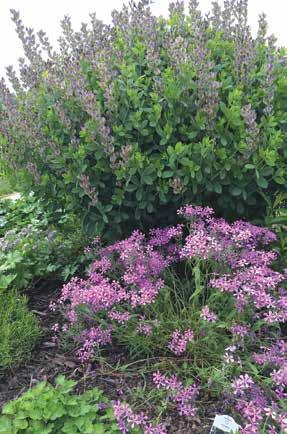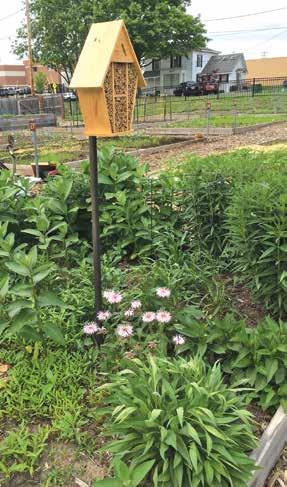
4 minute read
Spring Inspiration
Master Gardeners of Greater Kansas City host June garden tour
Spring has arrived and it’s time to get outside and enjoy beautiful weather. It will be the perfect opportunity to stroll gardens on June 11 and 12, from 9 a.m. to 4 p.m. The MU Extension Master Gardeners of Greater Kansas City is hosting their 2021 Garden Tour with 7+ gardens to tempt your senses. Here are descriptions of three sites you will want to visit in June. Ticket sales and more details about the tour to come. Until then, save the dates!
Blue Springs Historical Museum Garden
Started by Mary Potter as president of the Blue Springs Historical Society, this heritage plant garden outside the Blue Springs Historical Museum reflects the types of flowers that would have grown here in 1900, when the museum was first built.
The museum house was originally built by a prominent Blue Springs resident in 1906 and the grounds consequently hold historical interest for visitors. Many of the perennials are original to the first planting of the garden. A Kansas City Master Gardener was instrumental in its design and construction in 2010, and the garden has evolved over time to showcase native perennials particularly suited to tolerate Missouri’s climate.
These gardens boast heritage plants, like roses and herbs, as well as Missouri natives, both sun and shade varieties, including columbine, purple coneflowers, old-fashioned daylilies, lamb’s ears, clematis, butterfly weed, bee balm, Shasta daisies, loosestrife, and New England asters.
Not only is there a combination of flowers and herbs in the beds behind the museum house, but the historic 1879 hotel next door also has raised vegetable beds indicative of a working hotel housing rail travelers in the late 1800s.
Blue Springs Community Garden
The Community Garden in Blue Springs is not your average community garden. In an effort to address all types of gardening—not just vegetables—the Kansas City Master Gardeners have reserved five raised beds to highlight different gardening themes. Each bed contains an artful display box with information about the plants in that bed, often accompanied by handouts for visitors who are interested in recreating similar gardens themselves.
Here are the five Master Gardener raised beds you will find at the community garden:
The Rose Bed: There are eight different varieties of roses chosen for their varying color, height, and winter resistance. Be sure to pick up a handout about rose gardening in Kansas City and how to select the perfect rose for your yard.
The Missouri Natives Bed: The gardeners have planted popular native plants including an impressively enormous false indigo, purple poppy mallow, tickseed, coneflowers, and other natives—there is always something in bloom.
The Monarch Bed: This certified Monarch waystation contains a variety of milkweeds, tickseed, rattlesnake master, and more. Handouts with information about Monarchs from the Missouri Department of Conservation are available at this station.
The Perennial Natives Bed: This next bed of natives is happily mixed with other perennials like coneflowers, daylilies, and snapdragons.
The Vegetable Bed: Each year the vegetable selections change, giving the ability to grow unusual produce for the community to sample. There is a box for seasonal recipes and sample bed diagrams for taking home. A nearby stand allows community gardeners to share their extra produce with others in the garden.
When visiting this garden, please sign up for the raffle to win the garden basket full of gardening supplies!
Above: The enormous false indigo, and blooming phlox underneath are planted in the Missouri Natives Bed. Below: A mason bee house welcomes important pollinators to the Perennial Bed. Both located at the Blue Springs Community Garden. Hundreds of Hostas
Shades of green and a variety of textures— from feathery grasses to hardy magnolias to the delicate leaves of Japanese maples—permeate this well-kept and manicured garden. The grass is lush and vibrant, and flower beds like verdant islands rise up from the lawn with tulips, Asian lilies, tree lilies, hibiscus, and various other healthy and happy perennials.
While the garden may seem organized and happily balanced today, this process was a labor of love as well as hard work. The owners had originally purchased the lot with unhealthily overgrown trees that had not been pruned nor cared for in some time. Thoughtful pruning and management of the trees allowed more sun to filter into the garden, and flower beds were created wherever trees were removed. Still a woodland, the garden is now also a healthy and colorful peaceful retreat.
In addition to the plants, this garden treats the viewer with artistic installments, including water fountains, wind sculptures, and decorative stone features, all rising from the depths of the thriving, prolific greenery surrounding them.
This garden draws in leisurely strollers with soft paths of lawn inviting exploration beneath the trees and borders overflowing with hundreds of hostas, five varieties of redbuds, prolific hydrangeas, ninebark, and caladiums.
The advice owners offer to home gardeners hoping to create their own shady paradises? Bring in several truckloads of compost each year!











